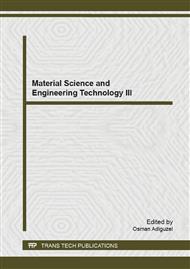p.104
p.108
p.115
p.120
p.124
p.129
p.134
p.138
p.144
Phase Transitions and Elementary Processes in Shape Memory Alloys
Abstract:
Shape memory effect is a peculiar property exhibited by certain alloy systems, and shape memory alloys are recognized to be smart materials. These alloys have important ability to recover the original shape of material after deformation, and they are used as shape memory elements in devices due to this property. The shape memory effect is facilitated by a displacive transformation known as martensitic transformation. Shape memory effect refers to the shape recovery of materials resulting from martensite to austenite transformation when heated above reverse transformation temperature after deforming in the martensitic phase. These alloys also cycle between two certain shapes with changing temperature.Martensitic transformations occur with cooperative movement of atoms by means of lattice invariant shears on a {110} - type plane of austenite matrix which is basal plane of martensite.Copper based alloys exhibit this property in metastable β-phase field. High temperature β-phase bcc-structures martensiticaly undergo the non-conventional structures following two ordered reactions on cooling, and structural changes in nanoscale level govern this transition cooling. Atomic movements are also confined to interatomic lengths due to the diffusionless character of martensitic transformation.
Info:
Periodical:
Pages:
124-128
Citation:
Online since:
April 2015
Authors:
Price:
Сopyright:
© 2015 Trans Tech Publications Ltd. All Rights Reserved
Share:
Citation:


